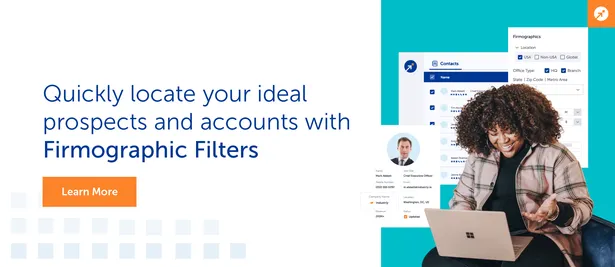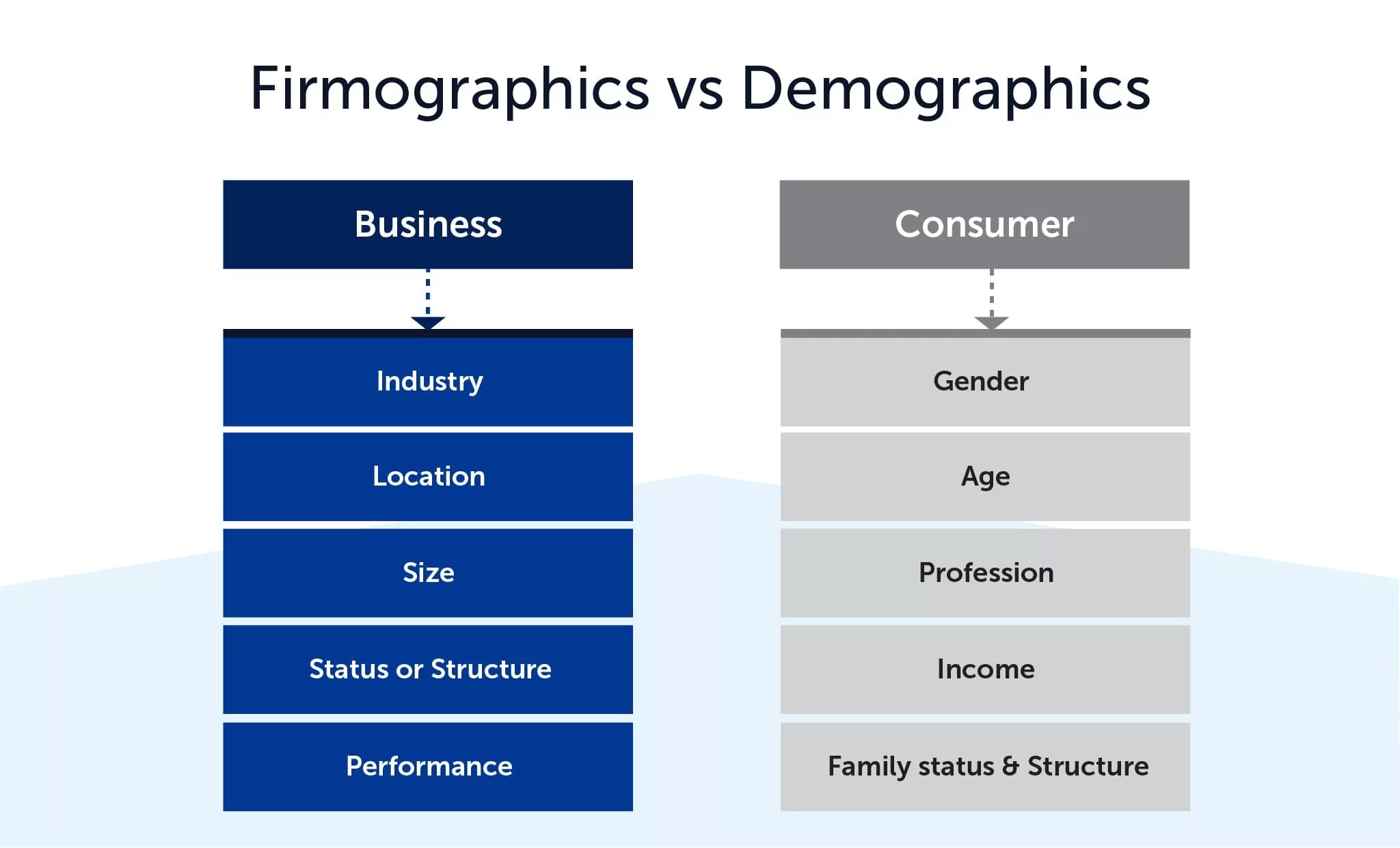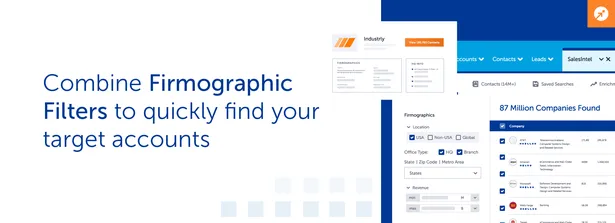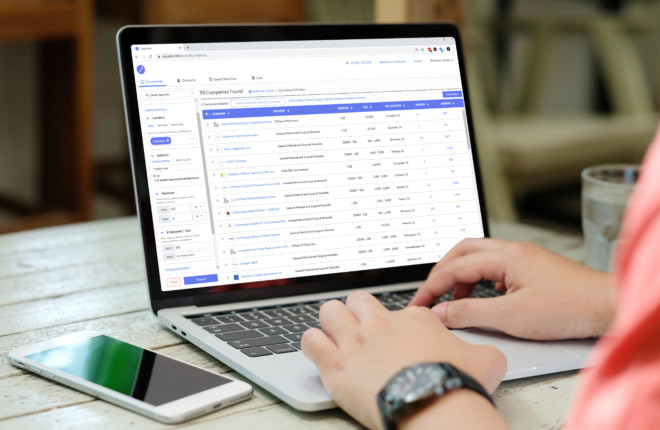One of the biggest challenges in B2B sales is to identify the right prospects. Businesses pay large amounts of money to fill their sales funnel; however, most of these leads are unqualified. Even when they are qualified, if you can’t properly segment your audience on firmographic and technographic references, the effectiveness of your outreach will suffer.
Segmenting your audience makes it much easier to create relevant content that is used to convert prospects into leads and customers. As the old marketing saying goes, “if you target everyone, you target no one.”
In this article, we will walk you through what firmographic data is, what it includes, and how you can apply it to make your sales and marketing efforts more productive.
Let’s jump in.
What Is Firmographic Data?
B2B demographics, in the business world, are called firmographic info.
Firmographic information encompasses company-wide information and detailed user-level information. B2B segmentation with firmographics lets you paint a picture of who your customers are so that you can reach specific markets with appropriate content.
Firmographic data include details like:
- Annual Revenue
- Type of Industry
- Number of Employees
- Location(s)
- Decision-Makers
Although firmographic data alone is not enough to create highly relevant content for your buyers, it is the place to start your segmentation process.

Key Information Firmographic Data Provides
Considering the importance of reaching only potential customers, firmographic data is critical for making your marketing and sales team efficient. Using firmographic data to improve your targeting allows your team to find more success without additional investment since less time and energy are wasted on unqualified prospects.
So how do you gather firmographic data that’s relevant to your brand and can help drive corporate success?
It all starts with asking the right questions. Commonly-used queries include:
- When was the company established?
- What industry is the company in?
- How many employees work for the company?
- How many employees work at each location of the company?
- What is the company’s revenue?
- What percentage of the target market share does the company currently hold?
- Is the company currently experiencing growth, downsizing, or maintaining stability?
- Could you describe the organizational structure, such as whether it follows flat leadership or a standard hierarchy?
Personalization is critical in B2B as we enter 2023.
According to the Salesforce State of Marketing report, 65% of businesses will consider switching vendors if a brand doesn’t make any effort to personalize communication.
The latest Salesforce report states that 84% of consumers – and 83% of company customers – claim that being handled as a human being rather than a number from a list of phone numbers or email addresses is the secret to winning their business. Buyers demand a consumer-like experience from brands whose deeply customized content is essential to make this possible.
Understanding your existing customers’ needs and supportive firmographic data helps you answer your prospects’ questions, solve their challenges, and understand their expectations.
Firmographic Data Examples
Let’s delve deeper into various aspects of firmographic data and their contributions.
Performance:
This data set focuses on an organization’s annual and quarterly revenue and relevant expenditure trends. By understanding their client potential, you can develop an effective long-term b2b sales strategy and address the company’s short-term needs. A company might not be at the level of success to consider your product, or they might be too big for you to adequately service. You need to find companies at the right stage of growth for you to provide the most value.
Industry:
This dataset delves into the conditions of your potential client’s primary industry, helping you grasp how your product or service aligns with their day-to-day operations. Different industries have diverse needs, and this information guides you in crafting messaging highlighting your business’s ability to meet those specific requirements.
Size:
This dataset encompasses the physical size of an organization, such as its brick-and-mortar structure and global reach, as well as the number of individuals working within it. Understanding the varying needs of businesses based on their size aids in tailoring your product’s use cases accordingly.
Ownership:
This dataset examines how control is distributed or organized within a particular business. Whether your target is publicly or privately owned, a cooperative venture, a non-profit, or a governmental organization, this insight provides valuable information about their sales potential. Your deal timeline and procedures will likely also vary based on company ownership. For example, a government organization tends to have a longer sales cycle and security considerations than privately owned businesses.
Growth Trends:
This dataset examines the development stage of an organization. Understanding whether your potential client is a new startup, experiencing growth, downsizing, or stabilizing allows you to adapt your marketing approach and optimize the contact-to-sales conversion pathway accordingly.
Where Does Firmographic Data Come From?
There are multiple resources available to collect the firmographic data.
- Business Directories and Listings
- Data Intelligence Tools
- Buying a List
That said, you must choose the most reliable data source. Business directories aren’t frequently updated. Same with buying a list as it involves risks of data errors. The fastest way to get updated data is by using a data intelligence tool.
Distinguishing Firmographics from Demographics
Firmographics and demographics are essential tools for constructing ideal customer profiles. The contrast lies in their respective applications: demographics segment individual consumers, while firmographics target potential client businesses. Demographics center around individuals, and firmographics focus on organizations.
Examples of demographic data include:
- Gender
- Age
- Profession
- Income
- Family status and structure (married/single, kids/no kids, etc.)
On the other hand, firmographic data covers:
- Industry
- Location
- Size
- Status or structure
- Performance
By analyzing demographic and firmographic data effectively, businesses can gain valuable insights to customize their marketing strategies and engage with their target audience optimally, whether it pertains to individual consumers or other organizations.

Firmagraphic Data Use Cases By Role
Firmographic data, which includes characteristics like industry, company size, revenue, location, and technology stack, is a powerful tool across various revenue-generating roles. Here’s how it specifically benefits BDRs, demand gen marketers, and RevOps:
Business Development Representatives (BDRs)
BDRs are on the front lines of prospecting and outreach. Firmographic data empowers them to be more efficient and effective:
Prioritize Ideal Customer Profiles (ICPs):
- Challenge: Limited time, vast number of potential accounts.
- Firmographic Solution: Filter accounts based on specific industry, employee count, or revenue ranges that align with their most successful customer profiles. This ensures they’re spending time on companies most likely to convert.
- Example: A BDR selling HR software might prioritize companies with 500-2000 employees in the tech or healthcare industry, as these are their typical ICPs.
Personalize Outreach at Scale:
- Challenge: Generic messaging leads to low response rates.
- Firmographic Solution: Craft tailored emails and call scripts that reference industry-specific pain points, company size challenges, or technology trends relevant to the prospect’s firmographics.
- Example: For a manufacturing company, a BDR might highlight how their solution improves supply chain efficiency, while for a software company, they’d focus on scalability and integration.
Identify Lookalike Accounts:
- Challenge: Exhausting current known ICPs.
- Firmographic Solution: Analyze the firmographics of their most successful customers and then identify other companies that share similar characteristics, expanding their target list with high-potential prospects.
- Example: If their top client is a B2B SaaS company with 100 employees using Salesforce, they can search for other B2B SaaS companies of similar size also using Salesforce.
Improve Cold Calling Effectiveness:
- Challenge: Lack of context during cold calls.
- Firmographic Solution: Quickly glean insights into the company’s industry, recent funding rounds, or growth trends to inform their opening statement and questions, demonstrating they’ve done their homework.
- Example: “I noticed your company recently closed a Series B funding round, which often comes with growth challenges around scaling operations. Is that something you’re experiencing?”
Account-Based Selling (ABS) Alignment:
- Challenge: Ensuring BDR efforts align with strategic accounts.
- Firmographic Solution: Work with sales and marketing to identify key accounts based on firmographic criteria (e.g., Fortune 500 companies in a specific sector) and then create targeted outreach plans for those accounts.
Demand Generation Marketers
Demand gen marketers are responsible for attracting and nurturing leads. Firmographic data helps them optimize their campaigns and improve ROI:
Targeted Ad Campaigns:
- Challenge: Wasting ad spend on irrelevant audiences.
- Firmographic Solution: Use firmographic filters on platforms like LinkedIn Ads or Google Ads to show ads only to decision-makers in companies that match their ICP (e.g., targeting marketing directors at companies with 200-1000 employees in the financial services industry).
- Example: A cybersecurity company might target IT leaders in healthcare organizations with over 500 beds.
Content Personalization and Distribution:
- Challenge: Generic content failing to resonate.
- Firmographic Solution: Develop content specific to different industries or company sizes (e.g., an ebook on “Cloud Migration Challenges for SMBs” vs. “Enterprise Cloud Strategy”). Distribute this content through channels most relevant to those firmographics.
- Example: A whitepaper on regulatory compliance might be promoted to legal firms, while a guide on agile development might be for software companies.
Lead Scoring and Prioritization:
- Challenge: Overwhelming number of leads, difficulty identifying sales-ready leads.
- Firmographic Solution: Incorporate firmographic data into lead scoring models.12 Leads from companies that align with the ICP receive higher scores, ensuring sales focuses on the most promising opportunities.
- Example: A lead from a company with 1000+ employees in their target industry might automatically get a higher score than a sole proprietor.
Website Personalization:
- Challenge: One-size-fits-all website experience.
- Firmographic Solution: Dynamically adjust website content, calls-to-action (CTAs), or even pricing information based on the visitor’s firmographics (inferred through IP lookup or previous interactions).
- Example: When a visitor from a large enterprise lands on the pricing page, they might see an “Enterprise Solutions” option, while an SMB might see a “Starter Package.”
Event and Webinar Strategy:
- Challenge: Attracting the right audience to events.
- Firmographic Solution: Plan events and webinars tailored to specific industries or company sizes. Promote these events using firmographic targeting to ensure relevant attendees.
- Example: Hosting a “Digital Transformation in Manufacturing” webinar specifically for manufacturers.
Revenue Operations (RevOps)
RevOps professionals are focused on optimizing the entire revenue engine. Firmographic data is crucial for their strategic initiatives and operational efficiency:
Sales Territory Planning:
- Challenge: Imbalanced territories, leading to unequal opportunities and stress.
- Firmographic Solution: Analyze the distribution of ICP accounts based on firmographics across different regions or sales teams to create more balanced and equitable territories.
- Example: Ensuring each territory has a similar number of target enterprise accounts based on revenue and employee count.
Sales Performance Analysis:
- Challenge: Difficulty identifying patterns in sales success or failure.
- Firmographic Solution: Segment sales data by firmographic attributes to identify which industries, company sizes, or tech stacks are most profitable, allowing for better resource allocation and strategy adjustments.
- Example: Discovering that deals with companies using a specific CRM close faster or have higher average contract values.
Customer Segmentation for Retention and Upsell:
- Challenge: Generic customer success strategies.
- Firmographic Solution: Segment existing customers by firmographics to identify common pain points, success metrics, and upsell opportunities. This allows for more targeted customer success initiatives and product development.
- Example: Identifying that mid-market clients in the retail sector are more likely to adopt a new inventory management module.
Forecasting Accuracy:
- Challenge: Inconsistent and unreliable sales forecasts.
- Firmographic Solution: Integrate firmographic data into forecasting models.17 By understanding the typical sales cycle and conversion rates for different firmographic segments, RevOps can improve the accuracy of revenue predictions.
- Example: Knowing that enterprise deals in a particular industry have a longer sales cycle and higher closing rate compared to SMBs.
Tech Stack Optimization:
- Challenge: Ensuring sales and marketing tools are effective.
- Firmographic Solution: Analyze the firmographics of customers using specific technologies to understand integration needs, competitive landscapes, and potential technology partnerships.
- Example: If many of their customers use a specific accounting software, RevOps might prioritize an integration with that software.
By leveraging firmographic data, BDRs, demand gen marketers, and RevOps teams can move beyond generic strategies to highly targeted, efficient, and ultimately more successful revenue-generating activities.
What is Firmographic Segmentation?
Imagine a marketer targeting specific markets, such as small tech start-ups on the West Coast or large commercial bakeries in the Midwest. Marketers find each segment’s distinct characteristics and purchasing behaviors essential to planning their approach. Marketers rely on firmographic segmentation to classify their customer markets to achieve targeted and relevant outreach.
When dealing with business-to-business (B2B) marketing, marketers conduct research based on industries, company size, geographical location, and other relevant factors to gain deeper insights into their markets. This segmentation approach allows them to position their products and services for their intended audience effectively.
Firmographic segmentation encompasses business descriptions, financial performance, and industry insights. B2B marketers are now incorporating firmographic data alongside other data to enhance their segmentation efforts. By combining several firmographic variables with technographic data and marketing interactions, marketing can qualify leads with the best chances of becoming closed deals. Market segmentation is one of the first steps to consistent revenue generation.
Benefits of Firmographic Segmentation
1. Potential clients can benefit from the knowledge.
Firmographic data can show how the company is funded and performing right now. Naturally, such knowledge is critical when selecting whether or not to invest. Furthermore, diverse firmographic data may help you better understand certain sectors and marketplaces because it exposes a lot about the organizations in the field.
2. Lead generation and scoring have been improved.
If you sell to companies, firmographic data will help you better segment the market and identify possible clients. This translates to more effective lead generation. It will also help you discern and rate leads, ensuring that your sales efforts are focused effectively.
3. Expanded sales intelligence.
When firmographic data is accessible, salespeople are better positioned to manage leads. Firms’ purchasing capacity and preferences may be assessed using the information on the company’s present standing, size, and other firmographics. Salespeople will be able to build stronger engagement plans and pitches as a result.
4. Personalized marketing and customer service.
Naturally, the more you know about a company, the better you can promote it. Furthermore, firmographic information aids in the provision of high-quality customer service, which is critical for acquiring and maintaining consumers. For example, understanding the firm’s geographical location allows you to be aware of opening hours and local events, aiding in easy communication.
What Is Firmographic Information Used For?
Firmographic data is used for creating personalized content strategies.
For instance, a buyer working for a Fortune 500 company has different requirements than a startup trying to scale rapidly. If they have different demographics, they will have different challenges and, thus, different objectives to achieve. Why would they read the same blog posts and watch the same videos?
Firmographic data is crucial for both sales reps and marketers. Even within a company, firmographic data is essential for creating personalized content.
1. Quickly Identify Qualified Sales Leads
Once you start incorporating firmographic data into your sales workflow, segmenting and identifying qualified prospects becomes easy.
Suppose your solution is relevant to B2B SaaS companies with over $500K in annual revenue, and you just want to see companies based in Austin, Chicago, and NYC. With a few clicks, you can instantly use a tool like SalesIntel to filter and identify companies that fit your requirements.
This makes it easy for your team to focus on targeting your qualified prospects rather than throwing darts in the dark.
2. Improve Sales And Marketing Messaging
77% of consumers have chosen, recommended, or paid more for a brand that provides a personalized experience.
Understanding your prospects’ revenue, the size of the company, locations, and other vital information will allow your team to send them relevant information about your offering and personalize their sales pitches and marketing communications.
When using firmographic data, you can speak to prospects and provide more value than ever.

3. Optimize Your Ad Targeting
Advertising based on assumptions is hard. If you make the wrong assumptions, you will waste money advertising to uninterested audiences. Instead, by collecting as much data as possible on your ideal prospects, you can then use that data to target your ads more effectively.
For example, if you run ads on LinkedIn, you can target audiences using several different types of firmographic data.
SalesIntel helps you identify companies that fit your firmographic requirements to be qualified as a lead. This way, you can have all the information to add to your LinkedIn audience while setting up your ad campaigns.
4. Account-Based Marketing (ABM)
We all know that with the rise of account-based marketing, firmographic data is a necessity. How does it apply to ABM?
Marketers have been using firmographic data for a long time to with their ABM strategy. However, for ABM, there are many use cases. ABM experts have long recognized the impact of bad data on ABM.
The whole idea behind ABM is to target specific and applicable accounts rather than selling and marketing to your entire total addressable marketing (TAM). When you identify who the right companies are, you can target these companies with super-personalized messaging.
The next step should be to collect verified contacts from those companies that suit your profile. Firmographic data, therefore, helps to initiate the process; that is, finding the right set of companies or accounts to target.
Additionally, Firmographic data can be used to create…
- Relevant email campaigns and newsletters
- Authoritative blog posts
- Tutorial and explainer videos about your company
- A/B testing
Firmographic data is crucial to ensure your team spends their time focusing on leads and companies who are well qualified for your product or service and to ensure your messages are as relevant as possible to your audience.
Every time you create a specific piece of content, keep a specific firmographic segment in mind. It sounds easy and exciting but takes practice, trial and error, and constant improvement.
Factors Considered While Creating Firmographic Target Marketing Strategies
Different variables can be utilized for firmographic segmentation, but most businesses and mid-size companies commonly employ the following firmographic data examples:
1. Company Size – Annual Revenue:
The size of an organization is determined by its income and number of employees. Recognizing the impact of marketing efforts on different-sized firms, successful businesses divide their clientele into various size segments, such as micro-companies, small businesses, mid-sized businesses, and large enterprises.
2. Industry:
Industry type is a natural variable, as certain sectors are more interested in specific goods and services. For instance, an advertising company targeting the education sector for investments in classroom technologies would not be interested in construction companies.
3. Location:
Location firmographics categorize organizations based on their geographical locations. Many companies are naturally limited to certain industries due to their location. By analyzing which geographic regions their marketing campaigns succeed in, businesses can focus more attention and effort on the specific segments of their target customers.
4. Company Structure:
Company structure reveals a firm’s legal status or the relationships between its constituent businesses. Companies may fall into categories like limited partnerships, corporations, sole proprietorships, partnerships, cooperatives, government organizations, non-profit organizations, or publicly-owned entities. Understanding the types of businesses most benefiting from their products or services enables firms to enhance the effectiveness of their sales and marketing campaigns.
5. Performance:
Firmographic segmentation by performance groups businesses based on their historical business execution. Metrics such as the period of existence, growth or decrease rates, or gains and losses, can indicate the suitability of a business as a long-term customer.
How to Use Firmographic Data to Convert Leads Into Clients
Here’s how to use firmographic data to convert leads into clients:
1. Identify the Different Segments You Are Attracting:
Utilizing firmographic data, segment your engaged marketing audience on essential criteria like company size, industry, location, and organizational structure. By understanding the segments you attract, you can tailor your strategies to meet the specific needs and preferences of each group.
2. Understand Your Ideal Customer Profile (ICP):
Leverage firmographic data to build a detailed Ideal Customer Profile (ICP). Analyze the characteristics of your best-performing clients and identify patterns among them. With a clear ICP, you can focus your efforts on attracting leads that closely match your ideal customer, increasing the chances of conversion. Compare your ICP with the marketing audience you are attracting and targeting to see if they align or if your marketing needs to be adjusted.
3. Create More Relevant Messaging and Offers:
Armed with firmographic insights, craft personalized messaging and offers that resonate with each segment’s unique needs and pain points. Tailoring your content to address specific challenges and preferences will make your marketing efforts more compelling, enhancing the likelihood of converting leads into clients.
4. Improve Marketing Campaigns and Targeting:
Utilize firmographic data to refine your marketing campaigns. Target your messaging, advertising, and content distribution to reach the right segments effectively. You can optimize your marketing ROI and conversion rates by focusing on the most promising leads and strategically directing your resources. Every minute spent on content creation and dollar spent on ads count.
5. Qualify, Identify, and Convert Leads Through Lead Scoring:
Implement lead scoring based on firmographic attributes and other relevant data points like engagement levels and behavior. Assign higher scores to leads matching your ICP and showing active interest. This process helps prioritize leads, allowing your sales team to concentrate on the most qualified prospects and improve the conversion process.
Firmographic data is a powerful tool that can significantly impact your lead-to-client conversion rate. By understanding the different segments you attract, defining your Ideal Customer Profile, crafting personalized messaging, optimizing marketing campaigns, and implementing lead scoring, you can maximize the efficiency and effectiveness of your lead conversion efforts, ultimately growing your customer base and driving business success.
Integration with Other Data Types
Integrating firmographic data with other types of data such as technographic, demographic, and intent data, provides a multi-faceted understanding of your target market and clients. Here are the benefits of such integration:
- Technographic Data:
This data reveals a company’s technologies and tools. By combining it with firmographic data, you can tailor your marketing and sales strategies to highlight how your product or service integrates with the company’s existing tech stack, potentially increasing the relevance and appeal of your offerings. - Demographic Data:
This includes information about the individuals within the companies you target, such as age, gender, and job role. When combined with firmographic data, it allows for more personalized and effective communication strategies. For instance, you can craft messages that resonate with the specific decision-makers within a company based on their demographic profiles. - Intent Data:
This data provides insights into a company’s online behavior, indicating their interest in certain products or services. Integrating intent data with firmographic data enables you to identify which companies are actively looking for solutions like yours and tailor your outreach accordingly. This increases the likelihood of engaging prospects who are already in the buying process.
A Holistic View
Combining different data types offers a comprehensive view of potential clients and markets, enabling more informed and strategic decision-making. Here’s how.
- 360-Degree Customer Profile:
By integrating firmographic, technographic, demographic, and intent data, you can build a 360-degree profile of your potential clients. This holistic view includes their company characteristics, the technologies they use, the key individuals you need to engage, and their current interests and needs. Such detailed profiles allow for highly targeted and personalized marketing and sales efforts. - Market Segmentation and Targeting:
A holistic approach enables more precise market segmentation. You can identify niche markets or specific segments within broader markets that are most likely to benefit from your products or services. This improves the efficiency and effectiveness of your marketing campaigns. - Enhanced Predictive Analytics:
With a comprehensive data set, predictive analytics becomes more accurate. You can better forecast market trends, customer behaviors, and potential opportunities or risks. This foresight helps in proactive decision-making and strategic planning. - Improved Customer Engagement:
Understanding the full context of your customers’ needs and behaviors allows for more meaningful interactions. You can engage customers at the right time, with the right message, through the right channels, enhancing the overall customer experience and fostering long-term relationships.
The integration of firmographic data with other data types transforms raw information into actionable insights, providing a deeper understanding of your market and enabling more effective business strategies.
Technological Advancements
AI and Machine Learning
Advancements in Artificial Intelligence (AI) and Machine Learning (ML) are significantly enhancing the collection and analysis of firmographic data. Here’s how.
- Data Collection:
AI-powered tools can efficiently crawl and scrape data from a vast array of online sources such as company websites, social media, news articles, and business directories. This automation accelerates the data collection process, ensuring that the information is comprehensive and up-to-date. - Data Accuracy and Quality: Machine learning algorithms can clean and validate firmographic data by identifying and correcting inconsistencies, duplications, and inaccuracies. This ensures that the data used for analysis and decision-making is reliable.
- Predictive Analytics:
AI and ML can analyze historical firmographic data to identify patterns and trends. This allows businesses to predict future market behaviors and company growth trajectories, enabling more proactive and strategic decision-making. - Enhanced Segmentation:
Machine learning models can analyze vast datasets to uncover intricate patterns and correlations that might not be evident through traditional analysis. This helps in creating more precise market segments and customer profiles. - Real-Time Insights:
AI-driven tools can process and analyze data in real time, providing businesses with immediate insights. This is particularly valuable for responding swiftly to market changes and emerging opportunities.
Automation
Automation plays a crucial role in updating and maintaining firmographic databases. Here’s how automation contributes.
- Continuous Updates:
Automated systems can continuously monitor data sources and update firmographic databases with the latest information. This ensures that the data remains current and relevant, which is critical for accurate analysis and decision-making. - Efficient Data Management:
Automation reduces the manual effort required to manage large volumes of data. Automated processes can handle data entry, categorization, and integration seamlessly, freeing up human resources for more strategic tasks. - Scalability: Automated systems can scale effortlessly to handle increasing amounts of data as businesses grow. This scalability ensures that the firmographic database can expand without compromising on data quality or processing speed.
- Data Integration:
Automation facilitates the integration of firmographic data with other business systems such as CRM, ERP, and marketing automation platforms. This integration ensures that all business functions have access to consistent and up-to-date firmographic information. - Error Reduction:
By minimizing manual intervention, automation reduces the likelihood of human errors in data entry and maintenance. This enhances the overall integrity and reliability of the firmographic database. - Compliance and Security:
Automated systems can be programmed to adhere to data privacy regulations and ensure that sensitive information is handled securely. This helps businesses maintain compliance with legal standards and protect their data assets.
Advancements in AI and machine learning, coupled with the power of automation, are transforming the way businesses collect, analyze, and maintain firmographic data. These technologies enable more accurate, efficient, and scalable data management, providing businesses with the insights they need to make informed and strategic decisions.
Firmographic Data Vendors and Providers
Firmographic vendors provide data and information about other businesses, allowing marketers and sales professionals to understand and target their ideal customers without having to gather data on their own. Here’s a brief overview of top-rated firmographic vendors and providers:
1. Salesintel:
SalesIntel offers a comprehensive database of B2B company information, including firmographics, contact details, technographics, and buying signals. You get access to firmographic data of over 24.5 Million Accounts covering 206 Industries and 350 Searchable Metro Areas.
2. Apollo:
Apollo is a platform that provides a wide range of data services, including firmographics, contact information, and sales insights. Their database helps sales teams find high-quality leads, understand their target audience, and streamline their sales processes.
3. Cognism:
Cognism is a data-driven sales acceleration platform that offers firmographic data, contact information, and intent data. It assists sales and marketing teams in finding new prospects, engaging with them, and converting leads into customers.
Read About – Cognism Alternative
4. Clearbit:
Clearbit specializes in providing firmographics and enriched data for B2B companies. Their platform helps businesses understand their customers better, personalize their marketing efforts, and improve lead generation.
5. Uplead:
Uplead is a lead generation platform that offers firmographic data and contact information for B2B companies. It assists sales teams in identifying potential customers and provides verified contact details to reach out effectively.
6. Seamless:
Seamless is a B2B lead generation and data enrichment platform that offers firmographic data, technographics, and other valuable insights. Their database helps businesses identify ideal customer profiles and improve their targeting strategies.
Read About – Seamless Alternative
7. ZoomInfo:
ZoomInfo is a comprehensive B2B database platform that provides firmographics, contact information, intent data, and more. It empowers sales and marketing teams with accurate data to identify prospects and engage with them more effectively.
Read About – Best Alternative to Zoominfo
Each of these firmographic vendors offers valuable data and tools to enhance businesses’ sales and marketing efforts, helping them to find and connect with their target customers more efficiently.
Access Only The Best Firmographic Data
The most significant challenges with personalization are gaining insight quickly enough (40%), having enough data (39%), and having accurate data (38%) (Source).
SalesIntel is a one-stop solution for all three challenges, as it gives you access to over 22 million accounts and 300+ million human-verified firmographic and technographic data points in one place at the click of a button. SalesIntel goes a step further and offers buyer Intent Data to help you identify ‘ready-to-buy’ prospects.
Many B2B data providers claim to offer accurate firmographic data. However, when it comes to accuracy and reliability, they may not have what you specifically need at a high level of accuracy.
The best example is one of the most popular companies in our industry that promotes itself for data accuracy, but the reality is far from the claims. For instance, a company like Toys ”R” Us, which declared bankruptcy in 2017 and ceased operations in 2018, still lists as employing 64,000 people in their database. If you’re paying for data, you want it to be data you’ll actually use.
For those trying to compare data providers, we have a handy head-to-head comparison.
SalesIntel’s data is re-verified by our human researchers every 90 days to ensure data accuracy. Additionally, if you need the data of your prospects or accounts that are not listed in our database, our team will provide you the accurate data with a quick turnaround (typically 24-48 hrs!) using our unique Research on Demand service.
When all is said and done, it is crucial for you, as a customer, to invest your budget and resources to access accurate data. After all, if your firmographic data is inaccurate then it’s impossible to reap its benefits.
FAQs on Firmographic Data
Here are some of the frequently asked questions on firmographic data:
What is firmographic data in B2B marketing?
Firmographic data refers to the characteristics of businesses such as industry, company size, revenue, and location that help segment and target customers in B2B marketing. Just like demographics describe individuals, firmographics describe companies, helping sales and marketing teams define and reach their Ideal Customer Profile (ICP).
Why is firmographic data important for B2B sales and marketing?
Firmographic data helps businesses identify high-potential accounts, personalize outreach, and allocate resources efficiently. Reliable insights enable data-driven decision-making that improves targeting accuracy, campaign performance, and overall ROI.
What are examples of firmographic data points?
Common firmographic data points include industry, company size, annual revenue, location, ownership type, and growth rate. These attributes allow teams to segment audiences effectively and focus efforts on the businesses most likely to convert.
How can businesses identify and target their Ideal Customer Profile (ICP) using firmographic segmentation?
By analyzing firmographic factors like company size, industry, and region, businesses can identify shared traits among their best customers. This helps create a clear ICP that guides targeted marketing and sales efforts toward similar, high-fit prospects.
How can firmographic segmentation improve marketing campaigns and ROI?
Firmographic segmentation enables marketers to tailor messaging, offers, and campaigns to specific customer segments. Reaching the right audience with relevant content leads to better engagement, higher conversion rates, and improved ROI.
How does firmographic data contribute to better customer segmentation and personalization?
Firmographic insights help businesses divide audiences based on shared characteristics and deliver more personalized experiences. This approach enhances engagement, builds stronger relationships, and reduces the time sales teams spend on low-quality leads.
How is firmographic data used for lead segmentation?
Firmographic data helps categorize leads based on company traits such as industry, size, or revenue. Businesses can tailor outreach strategies for each segment, which improves lead scoring, engagement, and overall conversion rates.
What are the key challenges in implementing firmographic segmentation strategies?
Common challenges include maintaining data accuracy, ensuring freshness, and integrating information across systems. Many businesses also struggle with overgeneralization, making it essential to use a trusted data provider like SalesIntel for reliable results.
Are there industry-specific considerations when applying firmographic segmentation?
Yes. Each industry has unique buying behaviors, challenges, and decision-making processes. Businesses should analyze their ICP within each vertical, adapt messaging accordingly, and refine their approach based on real-time data and feedback.
Where can I source reliable and comprehensive firmographic data?
Several B2B data providers offer firmographic insights, including SalesIntel, ZoomInfo, Clearbit, and Dun & Bradstreet. SalesIntel stands out for its human-verified accuracy, transparent data practices, and frequent updates that keep information fresh.
Why is it important to combine firmographic data with technographic, intent, and behavioral insights?
Combining firmographic data with technographic, intent, and behavioral insights gives a complete view of target accounts. It helps you understand who they are, what technology they use, what they are researching, and how they engage, enabling precise targeting and personalized communication.
How is firmographic data used in AI and LLM training?
Firmographic data supports AI and large language model training by providing business context and structure. It helps models analyze company characteristics, industry trends, and market segments, resulting in more accurate insights and predictive analytics for business applications.




